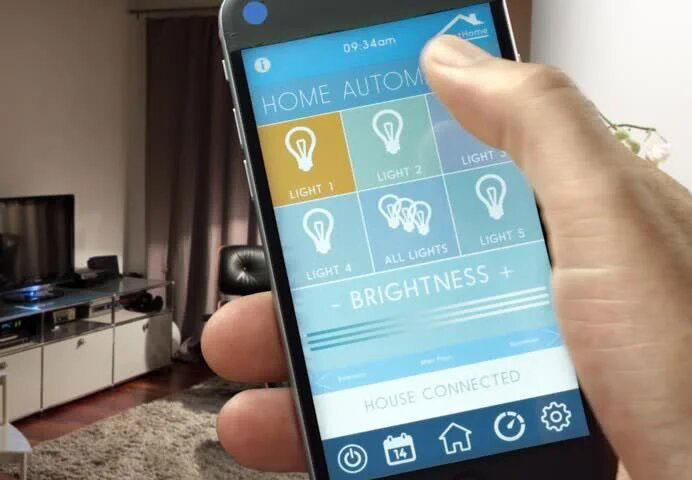
Home automation or domotics[1] is building automation for a home, called a smart home or smart house. A home automation system will monitor and/or control home attributes such as lighting, climate, entertainment systems, and appliances. It may also include home security such as access control and alarm systems. When connected with the Internet, home devices are an important constituent of the Internet of Things (“IoT”).
A home automation system typically connects controlled devices to a central hub or “gateway”. The user interface for control of the system uses either wall-mounted terminals, tablet or desktop computers, a mobile phone application, or a Web interface that may also be accessible off-site through the Internet.
While there are many competing vendors, there are increasing efforts towards open source systems. However, there are issues with the current state of home automation including a lack of standardized security measures and deprecation of older devices without backwards compatibility.
Home automation has high potential for sharing data between family members or trusted individuals for personal security and could lead to energy saving measures with a positive environmental impact in the future.
The home automation market was worth US$5.77 billion in 2013, predicted to reach a market value of US$12.81 billion by the year 2020.[2]
History
Early home automation began with labor-saving machines. Self-contained electric or gas powered home appliances became viable in the 1900s with the introduction of electric power distribution[3] and led to the introduction of washing machines (1904), water heaters (1889), refrigerators, sewing machines, dishwashers, and clothes dryers.
In 1975, the first general purpose home automation network technology, X10, was developed. It is a communication protocol for electronic devices. It primarily uses electric power transmission wiring for signalling and control, where the signals involve brief radio frequency bursts of digital data, and remains the most widely available.[4] By 1978, X10 products included a 16 channel command console, a lamp module, and an appliance module. Soon after came the wall switch module and the first X10 timer.
By 2012, in the United States, according to ABI Research, 1.5 million home automation systems were installed.[5] Per research firm Statista[6] more than 45 million smart home devices will be installed in U.S. homes by the end of the year 2018.[7]
The word “domotics” (and “domotica” when used as a verb) is a contraction of the Latin word for a home (domus) and the word robotics.[1] The word “smart” in “smart home” refers to the system being aware of the state of its devices, which is done through the information and communication technologies (ICT) protocol and the Internet of Things (IoT).[8]
Applications and technologies
Home automation is prevalent in a variety of different realms, including:
- Heating, ventilation and air conditioning(HVAC): it is possible to have remote control of all home energy monitors over the internet incorporating a simple and friendly user interface.[9][10]
- Lighting control system: a “smart” network that incorporates communication between various lighting system inputs and outputs, using one or more central computing devices.
- Occupancy-aware control system: it is possible to sense the occupancyof the home using smart meters[11] and environmental sensors like CO2 sensors,[12] which can be integrated into the building automation system to trigger automatic responses for energy efficiency and building comfort applications.
- Appliance control and integration with the smart gridand a smart meter, taking advantage, for instance, of high solar panel output in the middle of the day to run washing machines.[13][14]
- Home robots and security: a household security systemintegrated with a home automation system can provide additional services such as remote surveillance of security cameras over the Internet, or access control and central locking of all perimeter doors and windows.[15]
- Leak detection, smoke and CO detectors[16][17]
- Indoor positioning systems(IPS).
- Home automation for the elderly and disabled.
- Pet and Baby Care, for example tracking the pets and babies’ movements and controlling pet access rights.[18]
- Air quality control. For example, Air Quality Eggis used by people at home to monitor the air quality and pollution level in the city and create a map of the pollution.[19]
- Smart Kitchen and Connected Cooking.
- Voice controldevices like Amazon Alexa or Google Home used to control home appliances or systems.
Smart Home vs. Home Automation
Whether you’re researching smart bulbs or exploring the capabilities of your new voice assistant, you’ve probably encountered the terms Smart Home and Home Automation, and you’ve got yourself wondering, is there a difference?
While these two terms are sometimes used interchangeably and are closely related, they actually refer to slightly different things.
The term Smart Home generally refers to a class of electronic devices and sensors that can be controlled over the internet (or your local network) via your phone, computer or other devices. These devices will often have their own separate app or interface that you would use in order to control devices within certain ecosystem– for example Philips Hue smart-bulbs are Smart Home devices, and the manufacturer maintains their own app which you can use in order to control the devices within the Philips Hue ecosystem.
Home Automation, on the other hand, refers more to a methodology for using Smart Home devices. The idea behind Home Automation is to make these devices work automatically, responding to what you are doing while requiring little-to-no interaction with any sort of app or physical interface.
For example, let’s say you may have Philips Hue smart bulbs, and when you watch movies you like to have them all set up in a certain ‘scene’ (scene is general purpose term that refers to the a bunch of smart home devices set to a specific state). General smart-home use would be opening up the app on your phone and then pressing the button for the corresponding scene and then starting your movie– and then when you stop (or press pause) opening up the app again and pressing the button for the scene that you want to go back to. If you are into home automation, you would set up an automation that detected when a movie started playing and then automatically adjusted your lights to your ‘movie scene’ and then turned them back to normal when you pause or stop.
You can easily have smart home devices without doing any sort of home automation (but what’s the fun in that?) but it is very difficult to do any sort of home automation without some sort of smart home device.
To confuse matters more, often some smart home devices will have some home automation features built right into their core functionality– like the Nest thermostat, for example, automatically adjusts your temperature depending on whether it thinks you are home or away.
But built-in home automation features are not the only (and often not even the best) way to accomplish this functionality. Most home-automation enthusiasts will use some sort of hub software that serves as a middle-man to allow various devices and ecosystems to talk to each other and to use various small pieces of information from one another and combine this information to assemble the context it needs in order to better respond to more complex scenarios than any single set of devices can on their own. Hub software like this also has the added benefit of being a single point of control so that you can control all of the smart devices in your house without having to use a bunch of different apps for each device.

